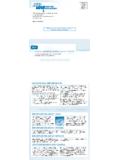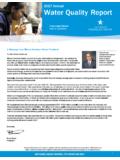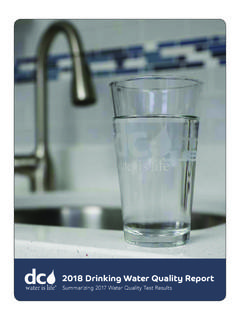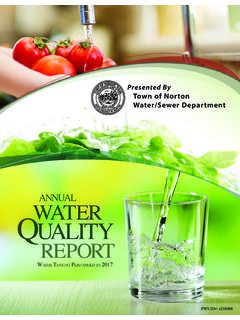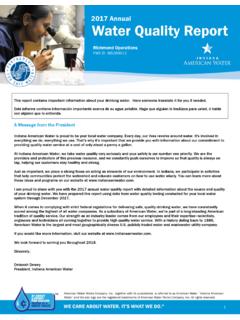Transcription of 2013 Annual Drinking Water Quality Report
1 2013 Annual Drinking Water Quality Report FALL RIVER Water UTILITY We re very pleased to provide you with the 2013 Annual Quality Water Report . We want to keep you informed about the excellent Water and services we have delivered to you over the past year. Our goal is and always has been, to provide to you a safe and dependable supply of Drinking Water every day. This Consumer Confidence Report will inform our customers about the Quality of our Drinking Water and assist them in in making good health decisions. Our Water source is from ground (well) Water . We draw from two wells located on Kane Street and at the Municipal Building at 641 South Main Street. The Kane Street well is 240 feet deep and the Main Street well is 300 feet deep. Dale Standke, President Fall River Village Board If you have any questions about this Report or concerning your Water utility, please contact or Public Works Supervisor, Craig Schultz at 484-3525. Craig and Dan are DNR certified ground Water and distribution system operators.
2 We strive to keep our customers informed about their Water utility. If you want to learn more, you are welcome to attend any of our regularly scheduled meetings, on the second Wednesday of every month at 6:00 at the Fall River Municipal Building. The Fall River Water Utility routinely monitors for constituents in you Drinking Water according to Federal and State laws. This table shows the results of our monitoring for the period of January 1st to December 31st, 2013 . All Drinking Water , including bottled Drinking Water , may be reasonably expected to contain at least small amounts of some constituents. It s important to remember that the presence of these constituents does not necessarily pose a health risk Water System Information If you would like to know more about the information contained in this Report , please contact Craig Schultz at (920) 484-3525. Opportunity for input on decisions affecting your Water Quality Second Wednesday of every month at 6 pm Health Information Drinking Water , including bottled Water , may reasonably be expected to contain at least small amounts of some contaminants.
3 The presence of contaminants does not necessarily indicate that Water poses a health risk. More information about contaminants and potential health effects can be obtained by calling the Environmental Protection Agency's safe Drinking Water hotline (800-426-4791). Some people may be more vulnerable to contaminants in Drinking Water than the general population. Immuno-compromised persons such as persons with cancer undergoing chemotherapy, persons who have undergone organ transplants, people with HIV/AIDS or other immune systems disorders, some elderly, and infants can be particularly at risk from infections. These people should seek advice about Drinking Water from their health care providers. EPA/CDC guidelines on appropriate means to lessen the risk of infection by cryptosporidium and other microbial contaminants are available from the Environmental Protection Agency's safe Drinking Water hotline (800-426-4791). Source(s) of Water Source ID Source Depth (in feet) Status 1 Groundwater 240 Active 2 Groundwater 300 Active To obtain a summary of the source Water assessment please contact, Craig Schultz at (920) 484-3525.
4 Educational Information The sources of Drinking Water , both tap Water and bottled Water , include rivers, lakes, streams, ponds, reservoirs, springs and wells. As Water travels over the surface of the land or through the ground, it dissolves naturally occurring minerals and, in some cases, radioactive material, and can pick up substances resulting from the presence of animals or from human activity. Contaminants that may be present in source Water include: Microbial contaminants, such as viruses and bacteria, which may come from sewage treatment plants, septic systems, agricultural livestock operations and wildlife. Inorganic contaminants, such as salts and metals, which can be naturally- occurring or result from urban stormwater runoff, industrial or domestic wastewater discharges, oil and gas production, mining or farming. Pesticides and herbicides, which may come from a variety of sources such as agriculture, urban stormwater runoff and residential uses.
5 Organic chemical contaminants, including synthetic and volatile organic chemicals, which are by-products of industrial processes and petroleum production, and can also come from gas stations, urban stormwater runoff and septic systems. Radioactive contaminants, which can be naturally occurring or be the result of oil and gas production and mining activities. In order to ensure that tap Water is safe to drink, EPA prescribes regulations that limit the amount of certain contaminants in Water provided by public Water systems. FDA regulations establish limits for contaminants in bottled Water , which shall provide the same protection for public health. Definitions Term Definition AL Action Level: The concentration of a contaminant which, if exceeded, triggers treatment or other requirements which a Water system must follow. MCL Maximum Contaminant Level: The highest level of a contaminant that is allowed in Drinking Water . MCLs are set as close to the MCLGs as feasible using the best available treatment technology.
6 MCLG Maximum Contaminant Level Goal: The level of a contaminant in Drinking Water below which there is no known or expected risk to health. MCLGs allow for a margin of safety. MFL million fibers per liter MRDL Maximum residual disinfectant level: The highest level of a disinfectant allowed in Drinking Water . There is convincing evidence that addition of a disinfectant is necessary for control of microbial contaminants. MRDLG Maximum residual disinfectant level goal: The level of a Drinking Water disinfectant below which there is no known or expected risk to health. MRDLGs do not reflect the benefits of the use of disinfectants to control microbial contaminants. mrem/year millirems per year (a measure of radiation absorbed by the body) NTU Nephelometric Turbidity Units pCi/l picocuries per liter (a measure of radioactivity) ppm parts per million, or milligrams per liter (mg/l) ppb parts per billion, or micrograms per liter (ug/l) ppt parts per trillion, or nanograms per liter ppq parts per quadrillion, or picograms per liter TCR Total Coliform Rule TT Treatment Technique: A required process intended to reduce the level of a contaminant in Drinking Water .
7 Detected Contaminants Your Water was tested for many contaminants last year. We are allowed to monitor for some contaminants less frequently than once a year. The following tables list only those contaminants which were detected in your Water . If a contaminant was detected last year, it will appear in the following tables without a sample date. If the contaminant was not monitored last year, but was detected within the last 5 years, it will appear in the tables below along with the sample date. Microbiological Contaminants Contaminant MCL MCLG Count of Positives Violation Typical Source of Contaminant Coliform (TCR) presence of coliform bacteria in >=5% of monthly samples 0 2 Yes, Ended 8/23/ 2013 Naturally present in the environment Inorganic Contaminants Contaminant (units) Site MCL MCLG Level Found Range Sample Date (if prior to 2013 ) Violation Typical Source of Contaminant CHROMIUM (ppb) 100 100 0 0 - 0 8/2/2011 No Discharge from steel and pulp mills; Erosion of natural deposits FLUORIDE (ppm) 4 4 - 8/2/2011 No Erosion of natural deposits; Water additive which promotes strong teeth; Discharge from fertilizer and aluminum factories NITRATE (N03-N) (ppm) 10 10 - No Runoff from fertilizer use; Leaching from septic tanks, sewage; Erosion of natural deposits SELENIUM (ppb) 50 50 2 0 - 2 8/2/2011 No Discharge from petroleum and metal refineries; Erosion of natural deposits.
8 Discharge from mines SODIUM (ppm) n/a n/a - 8/2/2011 No n/a Contaminant (units) Action Level MCLG 90th Percentile Level Found # of Results Sample Date (if prior to 2013 ) Violation Typical Source of Contaminant COPPER (ppm) AL= 0 of 10 results were above the action level. 8/10/2011 No Corrosion of household plumbing systems; Erosion of natural deposits; Leaching from wood preservatives LEAD (ppb) AL=15 0 0 of 10 results were above the action level. 8/11/2011 No Corrosion of household plumbing systems; Erosion of natural deposits Health effects for any contaminants with MCL violations/Action Level Exceedances Contaminant Health Effects Coliform (TCR) Coliforms are bacteria which are naturally present in the environment and are used as an indicator that other, potentially-harmful, bacteria may be present. Coliforms were found in more samples than allowed and this was a warning of potential problems. Additional Health Information If present, elevated levels of lead can cause serious health problems, especially for pregnant women and young children.
9 Lead in Drinking Water is primarily from materials and components associated with service lines and home plumbing. Fall River Waterworks is responsible for providing high Quality Drinking Water , but cannot control the variety of materials used in plumbing components. When your Water has been sitting for several hours, you can minimize the potential for lead exposure by flushing your tap for 30 seconds to 2 minutes before using Water for Drinking or cooking. If you are concerned about lead in your Water , you may wish to have your Water tested. Information on lead in Drinking Water , testing methods, and steps you can take to minimize exposure is available from the Safe Drinking Water Hotline or at Corrective Actions Taken The Village followed its Emergency Action Plan buy notifying the public while emergency chlorinating the system. We had several Water main breaks that were then fixed to resolve the problems. Information on Monitoring for Cryptosporidium and Radon Our Water system did not monitor our Water for cryptosporidium or radon during 2013 .
10 We are not required by State or Federal Drinking Water regulations to do so.

